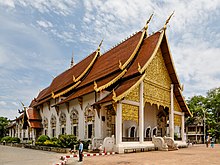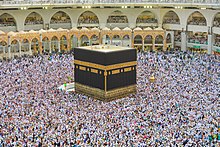Religious community

A religious community is a community (group of people) who practice the same religion. The term is used to refer to members of a religion who live within a community, but not segregated from others and not dedicated solely to their faith. They worship together in a religious venue such as a temple, synagogue, church or mosque. In many religions, a group worshipping in common is called a congregation. In a narrower sense, a religious community[1][2] is a group of people of the same religion living together specifically for religious purposes, often subject to formal commitments such as religious vows, as in a convent or a monastery.[3] Most religious communities are part of the way religions are organized, and most religions have some form of Religious order.
Christianity[edit]

Christianity has had a variety of religious groups dating back to the early church. Christian monasticism began in the Eastern churches, and eventually moved to the west.[4]
Catholicism[edit]
Religious Order[edit]
In the Catholic Church, a religious order is a community of consecrated life that is also an Institute.[5] Their members that take solemn vows. In the church, they are a type of religious institute. Under the broad category of religious order are canons regular and monasteries, mendicants and clerics regular.[6]
Religious Congregation[edit]
A Congregation is a type of department of the Roman Curia,[7] ranking below the two Secretariats, and above the pontifical councils, pontifical commissions, tribunals and offices.[8]
Monasteries and convents[edit]
In the Western church, the concept of monasticism was patterned after the Eastern church. Monasteries and convents became an important part of European life.[4]

Parish[edit]
A parish is a religious community within a particular church, led by a parish priest, under the authority of the diocesan bishop. It is the lowest ecclesiastical subdivision in the Catholic episcopal polity, and the primary constituent unit of a diocese or eparchy. In the 1983 Code of Canon Law, parishes are constituted under cc. 515–552, entitled "Parishes, Pastors, and Parochial Vicars."[9]
Eastern Orthodoxy[edit]
Christian monasticism began in the Eastern Mediterranean in Syria, Palestine and Egypt. In the Eastern Orthodox Church, Oriental Orthodoxy, the Church of the East and Eastern Catholicism, monastic communities of monks and nuns followed the Rule of St Basil.[4]
Intentional communities[edit]
While not Christian in nature, an intentional community is a voluntary residential community designed to have a high degree of social cohesion. There are many secular communities, but monasteries, kibbutzim and ashrams are the religious versions.[10]
Lay religious communities are Christian examples of intentional communities. They include groups such as the Hutterites,[11] Anabaptist Bruderhof Communities,[12] Amish and some Mennonite churches, and the Shaker communities.[13]
Buddhist monasteries[edit]

In Buddhism, the Buddhist monastery (Vihāra) is a place for Buddhist monks and nuns (bhikkhu). In early Sanskrit and Pali texts, Vihāra meant any arrangement of dwellings for the bhikkhu. Over time, the concept evolved into an architectural style for living quarters for monks with an open shared space or courtyard.[14]
Hinduism[edit]
An ashram (Sanskrit: आश्रम, āśrama) is a spiritual hermitage or a monastery in Indian religions.[15] Traditionally, an ashram would be located far from human habitation, among natural surroundings conducive to spiritual instruction and meditation.[16]
Islam[edit]

In Islam, Ummah (Arabic: أمة [ˈʊmːæ]) is an Arabic word meaning "community", but is different from shaʻb (شعب [ʃæʕb]), which means a nation with common ancestry or geography. It is a synonym for ummat al-Islām (أمة الإسلام, 'the Islamic community'); and is commonly used to mean the collective community of Islamic people.[17]
The Quran typically refers to the ummah as a single group that shares common religious beliefs, specifically those that are the objects of a divine plan of salvation.[18]
See also[edit]
- Full communion in Christianity
- Religious congregation
- Religious organization
- Ghetto
References[edit]
- ^ "PRH - Start-up notification of religious community". Finnish Patent and Registration Office. September 19, 2019. Retrieved June 14, 2020. One definition of the requirements to be recognized as a "religious community"
- ^ "Find a Religious Community". Diocese of Portsmoth. 2019. Retrieved June 14, 2020. Example of use of the term "Religious Community"
- ^ Deegan, P.J. (1970). The monastery: life in a religious community. Creative Educational Society. ISBN 9780871910431. 79 pages.
- ^ a b c Burton-Christie, Douglas (1993). The Word in the Desert: Scripture and the Quest for Holiness in Early Christian Monasticism. New York: Oxford University Press. pp. 7–9. ISBN 978-0-19-508333-0.
- ^ Ryan, George (January 9, 2018). "What Is a Religious Order? The Major Catholic Religious Orders Easily Explained". uCatholic.
- ^ Álvarez Gómez, C.M.F., Jesús (1996). Historia de la vida religiosa (in Spanish). Vol. III. Madrid: Publicaciones Claretianas. ISBN 978-8479662417.
- ^ Wooden, Cindy (July 31, 2014). "Changing needs, changing names: Reform of Curia is Vatican tradition". The Catholic Sun. The Catholic Sun. Retrieved April 13, 2017.
- ^ "The Roman Curia - Index". Vatican.
- ^ "canon 518", Code of Canon Law
- ^ Shenker, Barry (1986). Intentional Communities (Routledge Revivals) : Ideology and Alienation in Communal Societies. Routledge. doi:10.4324/9780203832639. ISBN 978-0-203-83263-9. Retrieved September 20, 2021.
- ^ Ryan, John. "Hutterites". The Canadian Encyclopedia. Retrieved June 12, 2017.
- ^ Rajani, Deepika (July 25, 2019). "Inside The Bruderhof: The radical Christians living in an English village". inews.co.uk. Retrieved August 15, 2019.
- ^ Stein, Stephen J. (1992). The Shaker Experience in America. New Haven and London: Yale University Press. p. 94. ISBN 9780300059335.
- ^ Paul Dundas (2003). The Jains. Routledge. pp. 203–204. ISBN 1-134-50165-X.
- ^ Swami Swahananda (January 1, 1990). Monasteries in South Asia. Vedanta Press. pp. 92–. ISBN 978-0-87481-047-9.
- ^ Gopal, Madan (1990). K. S. Gautam (ed.). India through the ages. Publication Division, Ministry of Information and Broadcasting, Government of India. p. 70.
- ^ "Rohingyas and the Myth of Ummah". Kashmir Observer. January 5, 2017. Retrieved March 30, 2021.
- ^ Houtsma, M. Th (1987). E.J. Brill's First Encyclopaedia of Islam, 1913–1936. Brill. pp. 125–126. ISBN 9004082654.
Further reading[edit]
- Campbell, H. (2005). Exploring Religious Community Online: We are One in the Network. Digital formations. P. Lang. ISBN 978-0-8204-7105-1.
- Hanretta, S. (2003). Constructing a Religious Community in French West Africa: The Hamawi Sufis of Yacouba Sylla. University of Wisconsin--Madison.
External links[edit]
 Media related to Religious groups at Wikimedia Commons
Media related to Religious groups at Wikimedia Commons
